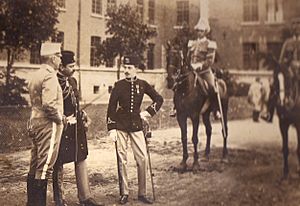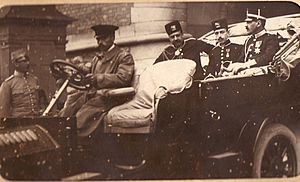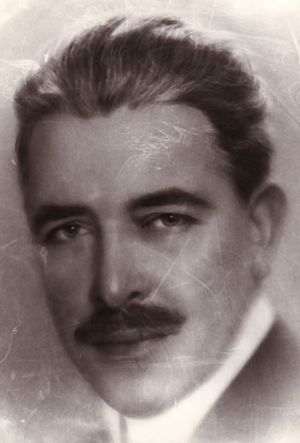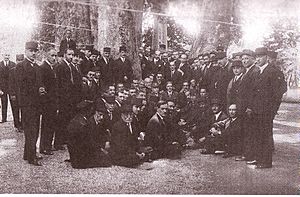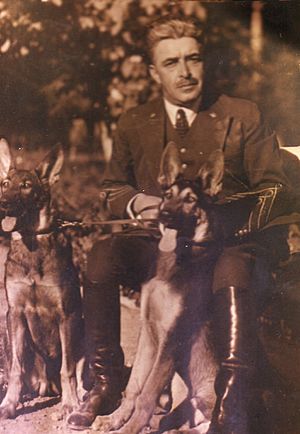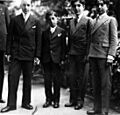Abdolhossein Teymourtash facts for kids
Quick facts for kids
Abdolhossein Teymourtash
عبدالحسین تیمورتاش |
|
|---|---|
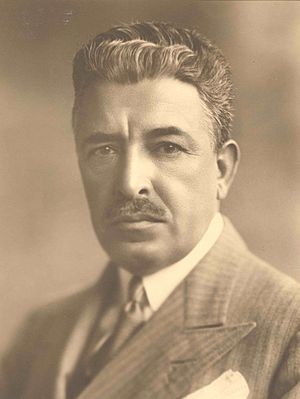 |
|
| Minister of Court of Iran | |
| In office 11 November 1925 – 3 September 1933 |
|
| Monarch | Reza Shah |
| Prime Minister | Mohammad-Ali Foroughi Mostowfi ol-Mamalek Mehdi Qoli Hedayat |
| Preceded by | New Title |
| Succeeded by | Mehdi Shoukati |
| Minister of Trade of Iran | |
| In office 28 October 1923 – 11 November 1925 |
|
| Monarch | Ahmad Shah Qajar |
| Prime Minister | Reza Pahlavi |
| Preceded by | Hassan Pirnia |
| Succeeded by | Mehdi Qoli Hedayat |
| Personal details | |
| Born | 25 September 1883 Bojnord, Sublime State of Persia |
| Died | 3 October 1933 (aged 50) Tehran, Imperial State of Persia |
| Nationality | Iranian |
| Political party |
|
| Relatives | Amirteymour Kalali Asadollah Alam |
| Signature |  |
Abdolhossein Teymourtash (Persian: عبدالحسین تیمورتاش; 25 September 1883 – 3 October 1933) was an important Iranian leader. He helped build modern Iran in the 20th century. From 1925 to 1932, he was the first Minister of Court for the Pahlavi dynasty. This was a very powerful position.
Teymourtash was important even before Reza Shah became king in 1925. He was elected to Iran's Parliament (Majles of Iran) many times. He also served as governor of Gilan and Kerman. He was also Minister of Justice and Minister of Public Works. People called him one of the most educated Iranians of his time. He helped shape Iran's ideas and culture in the early 1900s.
Contents
Growing Up and Education
Abdolhossein Khan Teymourtash was born in 1883. His family was well-known and owned a lot of land in Khorasan, Iran. When he was 11, his father sent him to Russia for school. This was to give him the best education.
He first went to a school in Ashgabat. Then he moved to Saint Petersburg. There, he joined the Imperial Nicholas Military Academy. This school was usually for the sons of Russian noble families. He studied military and administration. He also learned to speak Russian, French, and German very well. He became familiar with English too. During his 11 years in Russia, he loved Russian and French books. He was the first Iranian to translate works by famous Russian writers into Persian.
Coming Back to Iran
When Teymourtash returned to Iran, he spent six months improving his Persian. He read a lot of Persian poetry and literature. This helped him become a great speaker in Parliament later on. He married Sorour ol Saltaneh, who was related to important people. The king at the time gave him the title Sardar Moazzam Khorasani.
His first job was at the Ministry of Foreign Affairs. He worked as a Russian translator. Soon, he joined a group sent to Europe. Their job was to tell European leaders about the new Qajar King, Mohammad Ali Shah Qajar.
The Constitutional Revolution
Teymourtash was different from other rich Iranians. He wanted to help change Iran. He joined a group that supported the Iranian Constitutional Revolution. This revolution wanted to give people more rights.
Even though his father supported the king, Teymourtash joined the people who wanted a constitution. He became a leader in this group. He helped train volunteers to fight for their rights. They wanted a parliament and a constitution. The king's forces attacked Parliament and closed it down.
Becoming a Politician
The next year, Teymourtash was elected to the Majlis of Iran (Parliament). He was only 26 years old. He was re-elected many times over the years. When Parliament was not meeting, he took on other important jobs.
During World War I, Iran was neutral but suffered a lot. After the war, Britain tried to gain more control over Iran. They wanted Iran to give them power over its money, army, and foreign relations. Teymourtash was one of the first politicians to speak out against this. He helped write a statement signed by 41 members of parliament. This statement, called the "Statement of Truth," said no to the British plan. This helped stop the agreement.
Teymourtash was Governor of Gilan from 1919 to 1920. His main job was to fight against groups trying to separate from Iran. These groups were helped by the Soviet Union. His time as governor was short. Some historians say he used too much force, but there is no clear proof.
In 1921, a coup happened in Iran. Reza Khan (who would become Reza Shah) led the military part of this coup. Teymourtash refused to join the new government. He was arrested and exiled for a short time.
After being released, Teymourtash became Minister of Justice. He wanted to modernize Iran's court system. He got Parliament to approve changes and removed judges who were not good at their jobs. He also made state courts more powerful.
Later, he became Minister of Public Works. In 1924, he suggested a tax on tea and sugar. This money would pay for building the Trans-Iranian Railway. This railway was finished in 1937, using only Iranian money. He also helped end France's special right to dig for old treasures in Iran. This allowed other countries to help find Iran's ancient artifacts.
Teymourtash also loved literature and culture. He wrote many articles for a magazine called Daneshkadeh. He also helped get government money to copy old Persian writings from European libraries. He used his influence to help writers and historians. He even helped a famous poet get a seat in Parliament. He also had one of the biggest private libraries in Iran.
He started the Society for National Heritage in the 1920s. This group helped find old ruins, build tombs for famous poets, and create museums and libraries. This society helped build the tombs for Ferdowsi in 1934 and Hafez in 1938. Teymourtash believed Ferdowsi helped keep Iranian identity strong.
Minister of Court
In 1925, Teymourtash became the Minister of Court. This was a very important job, almost like a prime minister. He was chosen because he was smart and good at managing things. He helped build modern Iran.
Reza Shah trusted Teymourtash a lot. For the first seven years of Reza Shah's rule, Teymourtash was like the Shah's "other self." He was not officially part of the cabinet, but he was the most powerful person in the government. He helped make sure the government worked well. He was given the special title of Jenab-i-Ashraf (His Highness) in 1928.
Changes in Iran
As Minister of Court, Teymourtash helped create a modern government system. He worked hard to make sure the government had big goals. He helped Reza Shah and the Parliament work together.
Teymourtash, along with Firouz Mirza Nosrat-ed-Dowleh Farman Farmaian III and Ali Akbar Davar, led many changes. They wanted to make Iran strong and independent. They believed in a strong central government. This would help collect money and make big reforms. They also wanted to reduce the power of religious leaders in government.
They started many projects to develop Iran.
- Economy: They built railroads to connect cities and encourage trade. In 1926, a new School of Commerce was opened. A Chamber of Commerce was also created. The government helped private businesses grow. In 1928, the National Bank ("Bank-e Melli") was started. This bank took over jobs previously done by a British bank. New laws were made to protect property and encourage business.
- Education: Teymourtash played a big role in changing Iran's education system. From 1925 to 1932, he shared power with the Education Ministers. In 1926, the government started sending 100 students each year to Europe to study engineering and other subjects. They also worked to make state schools more important than traditional religious schools. In 1927, free education was offered to poor students. A standard curriculum was set for high schools.
- Girls' Education: They worked hard to get more girls into schools. In 1926, only 120 girls graduated. By 1932, this number grew to 3,713. Teymourtash's oldest daughter, Iran, started a group to create a boarding school for poor girls. His younger sister, Badri Teymourtash, became the first female dentist in Iran after studying in Belgium.
- Higher Education: In 1929, Teymourtash asked Isa Sadiq to plan for a university. This led to the creation of Tehran University later on.
Teymourtash tried to create a political party called Iran-e Now ("The New Iran"). He wanted to make Parliament more organized. Reza Shah approved this at first. But later, the Shah dissolved the party. He preferred to work with individuals rather than organized groups.
Teymourtash also started the Iran social club. This was the first club of its kind in Tehran. It became a popular place for educated people to meet. It also helped introduce new Western customs, like men and women mixing socially.
Foreign Relations
Iran's main goal in foreign policy was to reduce the power of foreign countries, especially Britain and the Soviet Union. Teymourtash was the main person in charge of Iran's foreign relations. He led many important talks and agreements.
In 1926, Teymourtash visited the Soviet Union. They made important trade agreements. He also worked to improve trade with other countries like the United States and Germany.
Iran also worked closely with its neighbors: Turkey, Iraq, and Afghanistan. These countries were also trying to modernize. They formed a loose alliance. This led to the Treaty of Saadabad in 1937, which was a non-aggression agreement between them.
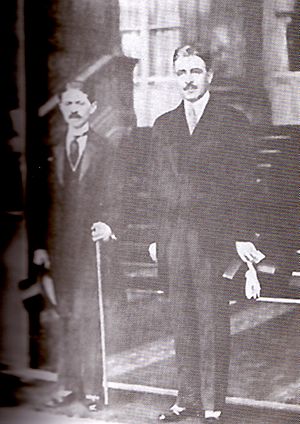
Teymourtash also worked hard to end "capitulation agreements." These were old agreements that gave special rights to foreign residents in Iran. He successfully ended all these agreements by 1928. This was a big win for Iran's independence.
He also pushed for changes to the oil agreement with the Anglo-Persian Oil Company (APOC). This company had a lot of control over Iran's oil. Teymourtash felt Iran was not getting a fair share of the profits. He wanted Iran to own 25% of APOC's shares. He also wanted more money from oil sales. He argued that the original agreement from 1901 was unfair.
Negotiations with APOC lasted from 1928 to 1932. Teymourtash argued that Iran's wealth was being wasted. He even brought in French and Swiss oil experts to help. He wanted to reduce the area where APOC could drill for oil. This would allow Iran to invite other oil companies to work in different areas.
In 1931, Iran's oil payments dropped a lot because of global economic problems. This made Teymourtash even more determined to change the agreement.
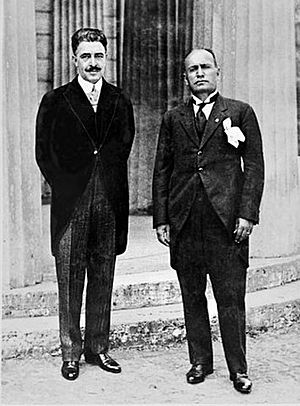
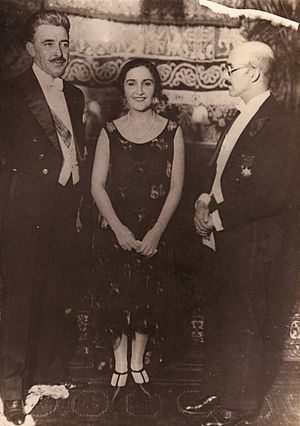
Dismissal and Death
Soon after, Teymourtash was removed from his job by Reza Shah. Weeks later, in 1933, he was arrested. It was rumored that his removal was linked to the oil negotiations with Britain. Some historians believe the British government tried to make Reza Shah suspicious of Teymourtash. They wanted Teymourtash removed from the oil talks.
After Teymourtash's arrest, a new oil agreement was made in 1933. This agreement gave APOC a new 60-year deal. It reduced the area of their control and guaranteed a minimum payment to Iran. However, many felt Iran gave up too much in this new deal.
Teymourtash remained in prison. He was accused of minor financial crimes. He was sentenced to five years in solitary confinement and had to pay a large fine. His health quickly got worse. He died on October 3, 1933, at the age of 50, in Qasr Prison in Tehran. Many believe he was killed by the prison doctor on the Shah's orders.
Family
After Teymourtash's death, the Iranian government took his land and property. His family was kept under house arrest for a long time. This included his mother, his younger sister Badri Teymourtash, his first wife Sorour ol-Saltaneh, and their four children: Manouchehr, Iran, Amirhoushang, and Mehrpour. His second wife, Tatiana, and her two young daughters were not held.
His children had to stop their studies in Europe and return to Iran. They were kept in exile until 1941. That year, Reza Shah was forced to step down, and his son Mohammad Reza Shah became king. The Teymourtash family was released, and some of their property was returned.
Mehrpour Teymourtash, who was a close friend of Mohammad Reza Shah, died in a car accident in 1941. Manouchehr Teymourtash later became a member of Parliament, following in his father's footsteps. Amirhoushang Teymourtash became a successful businessman. Iran Teymourtash earned a Ph.D. in literature and became a journalist. She was also awarded France's highest civilian honor.
Legacy
People at the time described Teymourtash as a person who showed all the different parts of modern Iran. For a long time after his death, his contributions were not talked about much. This was because the Pahlavi government wanted to focus only on Reza Shah's role. Later, after the Islamic Revolution, his work was also overlooked.
However, in recent years, Iranian historians have started to look at his role more fairly. They have found many documents that show how much he helped Iran. Many now see him as one of the most important thinkers and leaders in Iran's history. He worked hard for national reforms and protected Iran's interests in foreign dealings.
See Also
- Hossein Ala'
- Anglo-Iranian Oil Company
- Iran-United Kingdom relations
Images for kids
-
Amirhoushang Teymourtash while enrolled at Harrow School in England
-
Mehrpour Teymourtash (second from right) with Crown Prince Mohammad Reza Pahlavi (first from left) at Le Rosey in Switzerland.
Sources
- Teymurtash Documents and Correspondence (Reza Shah's Minister of Court 1925-1933) (Vezarate-h Farhang va Ershad Eslami: Tehran, 1383) ISBN: 964-422-694-1.
- Agheli, Bagher, Teymourtash Dar Sahneye-h Siasate-h Iran ("Teimurtash in the Political Arena of Iran") (Javeed: Tehran, 1371).
- Ansari, Ali, Modern Iran Since 1921: The Pahlavis and After (Longman: London, 2003) ISBN: 0-582-35685-7.
- Atabaki, Touraj & Erik J. Zurcher, Men of Order: Authoritarian Modernization Under Atatürk and Reza Shah (I.B. Tauris: London, 2004). ISBN: 1-86064-426-0.
- 'Alí Rizā Awsatí (عليرضا اوسطى), Iran in the Past Three Centuries (Irān dar Se Qarn-e Goz̲ashteh - ايران در سه قرن گذشته), Volumes 1 and 2 (Paktāb Publishing - انتشارات پاکتاب, Tehran, Iran, 2003). ISBN: 964-93406-6-1 (Vol. 1), ISBN: 964-93406-5-3 (Vol. 2).
- Cronin, Stephanie, The Making of Modern Iran: State and Society Under Reza Shah (Routledge: London, 2003) ISBN: 0-415-30284-6.
- Ghani, Cyrus, Iran and the Rise of Reza Shah: From Qajar Collapse to Pahlavi Power (I.B. Tauris: London, 2000). ISBN: 1-86064-629-8.
- Rezun, Miron, The Soviet Union and Iran: Soviet Policy in Iran from the Beginnings of the Pahlavi Dynasty Until the Soviet Invasion in 1941 by Miron Rezun (Westview Press: Boulder, 1980)
- Sheikholeslami, Javad, So-oud va Sog-out-e Teymourtash ("The Rise and Fall of Teymourtash") (Tous: Tehran, 1379) ISBN: 964-315-500-5.



